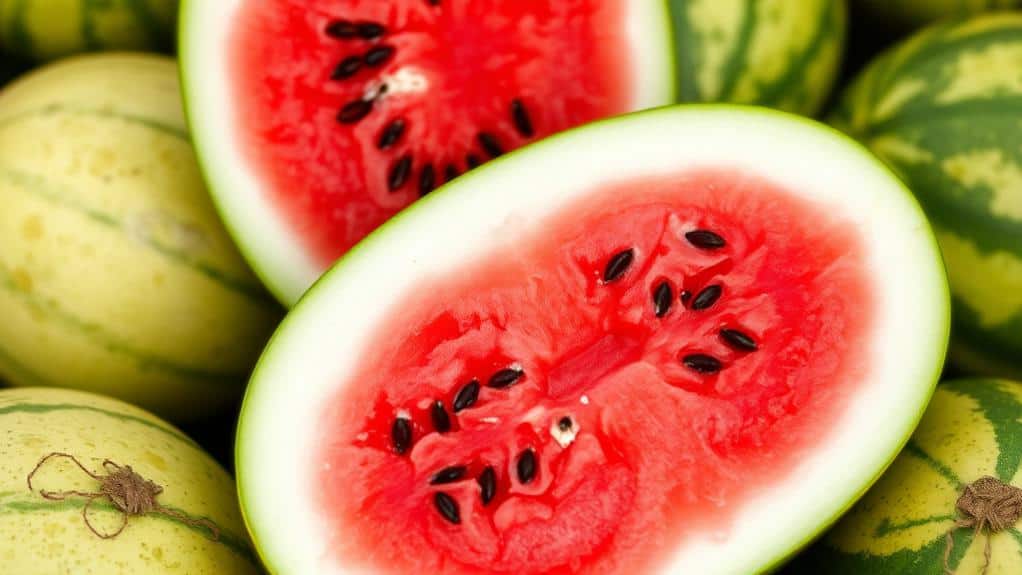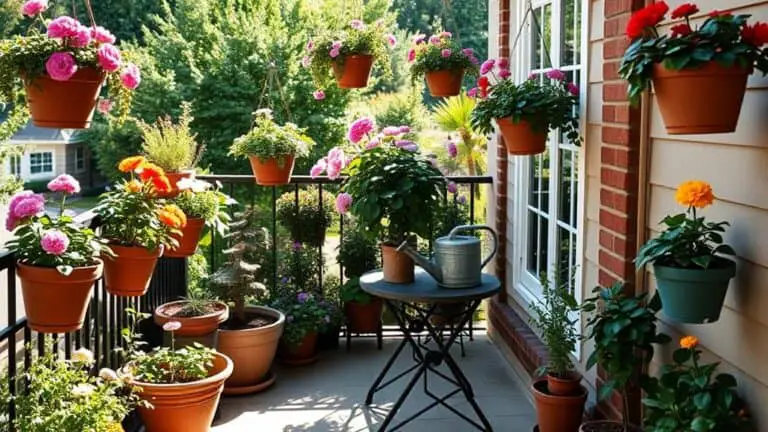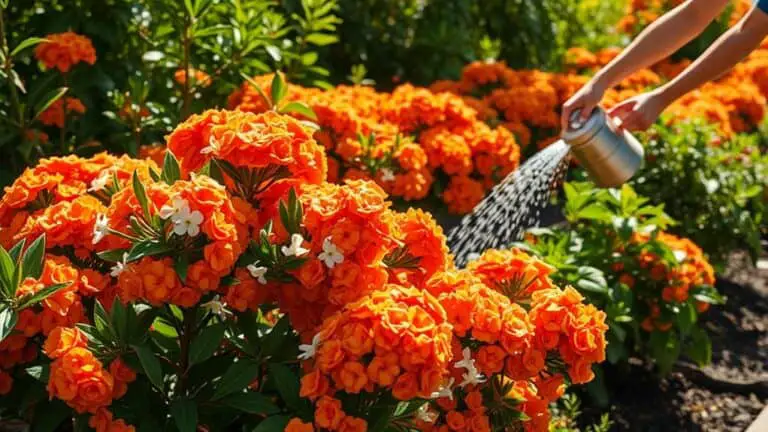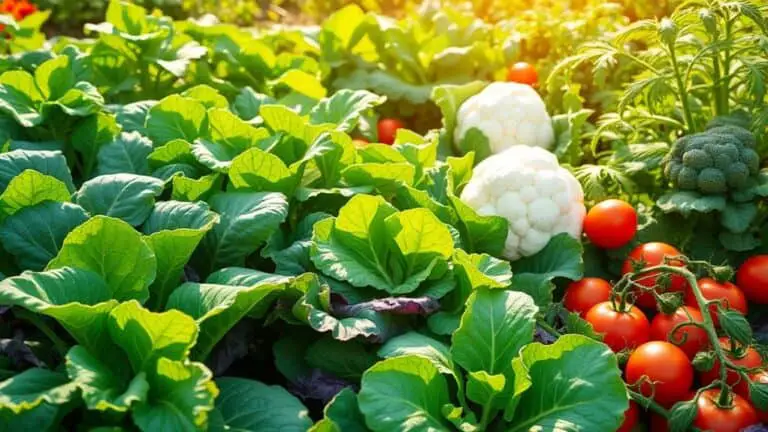Tips To Know When Your Watermelons Are Ripe
When it comes to picking the perfect watermelon, I know it can be tricky to determine ripeness without cutting it open. There are several key indicators to look for, and I've found a few that never fail. One of the first things I check is the field spot; a creamy yellow color usually signals maturity. The weight is another clue—ripe watermelons feel heavy for their size. But there's more to take into account, and some tips might surprise you. Curious about how to perfect your selection? Let's explore further.
Visual Indicators
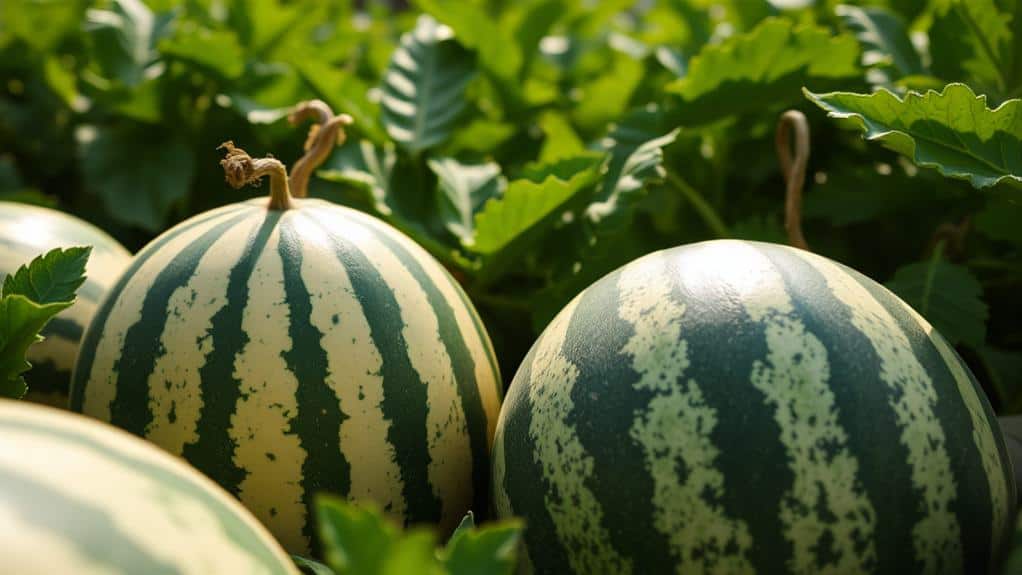
When you're selecting a watermelon, visual indicators can tell you a lot about its ripeness.
First, check for a creamy yellow field spot on the bottom, which means the watermelon ripened in the sun and has excellent flavor.
Look at the skin texture; a dull skin usually indicates a ripe watermelon, while a shiny skin often means it's not ready yet.
The color should be a vibrant green. Pale or dull green hues suggest under-ripeness.
Also, examine the shape; it should be uniform. Irregular shapes can signal uneven growth.
Finally, see if there's webbing or sugar spots on the surface—these are good signs of sweetness and ripeness.
Happy watermelon hunting!
Weight Test
After examining the visual cues, let's move on to another reliable method for determining a watermelon's ripeness: the weight test.
A ripe watermelon should feel heavy for its size, which means it's packed with water and ready to burst with juiciness. When you're selecting watermelons, compare the weight of similarly sized melons; the heavier ones are typically ripe and ready.
To double-check, you can use the thump test, but we'll focus on weight for now. Lift multiple watermelons to gauge which ones feel the heaviest.
Avoid those that feel unusually light for their size, as they might be underdeveloped or overripe. This simple weight test is a great way to verify you pick the perfect, ripe watermelon.
Sound Test
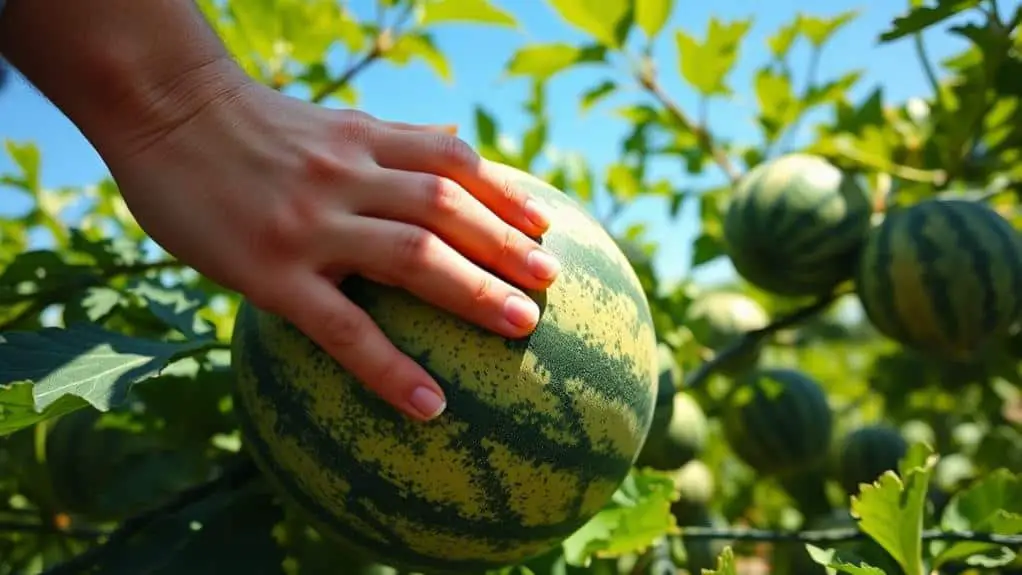
Let's plunge into the sound test, another effective method for determining a watermelon's ripeness. When you tap a watermelon, listen for a hollow sound. This indicates the fruit is ripe and full of juice. A deeper, resonant tone suggests ideal ripeness, while a dull sound might mean the melon is overripe. Checking multiple spots guarantees consistent sound quality, providing a more accurate ripeness check. A high-pitched sound often signals the watermelon isn't ripe yet. Developing this skill takes practice but is valuable for finding the best watermelons.
Here's a quick reference:
| Sound Type | Meaning | Action |
|---|---|---|
| Hollow sound | Ripe | Ready to eat |
| Deep, resonant tone | Ideal ripeness | Perfect choice |
| Dull sound | Overripe | Avoid |
| High-pitched sound | Underdeveloped | Needs more time |
Stem Examination
When checking if a watermelon is ripe, I always start by looking at the stem. A brown, dried stem is a good sign that the fruit is fully mature and ready to eat.
On the other hand, if the stem is green, it means the watermelon was picked too early and mightn't be as sweet or juicy.
Dryness Indicates Ripeness
Examining the stem of a watermelon is a reliable way to gauge its ripeness. A brown stem is a clear sign that the watermelon is ripe and has had enough time to mature on the vine.
In contrast, a green stem usually means the fruit was picked too early, so it mightn't be as sweet or flavorful. If you see a shorter stem or a slight indentation where the stem was attached, that's another good clue that the watermelon is ready to eat.
Just be cautious of stems that are too brittle or overly dry, as they could indicate overripeness or spoilage. Look for these signs to enjoy the juiciest, sweetest watermelons!
Green Stem Warning
A green stem on a watermelon is a clear warning sign that the fruit was harvested prematurely. When I'm picking out a watermelon, I always check the stem first. If it's green, I know it hasn't had enough time to fully ripen.
Instead, I look for brown or dried stems, which signal a ripe watermelon that matured on the vine. A short stem can also indicate ripeness, showing that the fruit developed properly.
However, be cautious of brittle stems, as they can mean the watermelon is overripe or even spoiled. Stem condition is essential in determining the best flavor and overall readiness of the fruit, so don't overlook this detail when you're selecting your watermelon.
Internal Testing
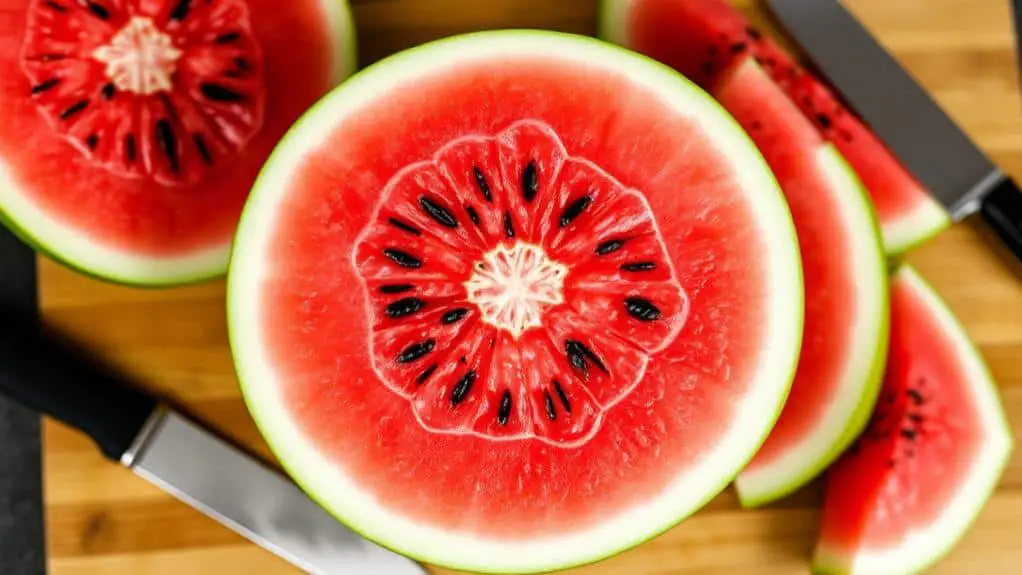
To guarantee you're picking the best watermelon, internal testing is crucial.
When you cut open a watermelon, look for vibrant red or pink flesh, which signals a ripe watermelon with ideal flavor. The texture should be crisp and juicy—avoid any that are mealy or mushy, as they're likely overripe. A uniform seed distribution is another good indicator of maturity.
Also, always check for internal defects like discoloration or irregularities, as these can point to spoilage. Taste is key: a ripe watermelon should be sweet. If it tastes bland or lacks flavor, it's probably not ripe.
Timing and Seasonality
Timing is everything when it comes to picking the best watermelon. Peak watermelon season runs from June to September, so you'll find the ripest fruit during these months. Late-season melons, typically harvested from August to September, are often the sweetest due to higher sugar content. Keep in mind that regional climate variations can affect ripening timing, so always consider local weather patterns. Early season watermelons might not be fully ripe, so I recommend choosing mid to late-season melons for ideal flavor. Buying from local farms during peak season guarantees better ripeness and freshness compared to store-bought options.
Here's a quick reference:
| Season | Ripeness | Sweetness |
|---|---|---|
| June | Early, less ripe | Less sweet |
| July | Mid-season, riper | Moderately sweet |
| August | Late-season, ripe | Very sweet |
| September | Peak ripeness | Sweetest |
Field Spot
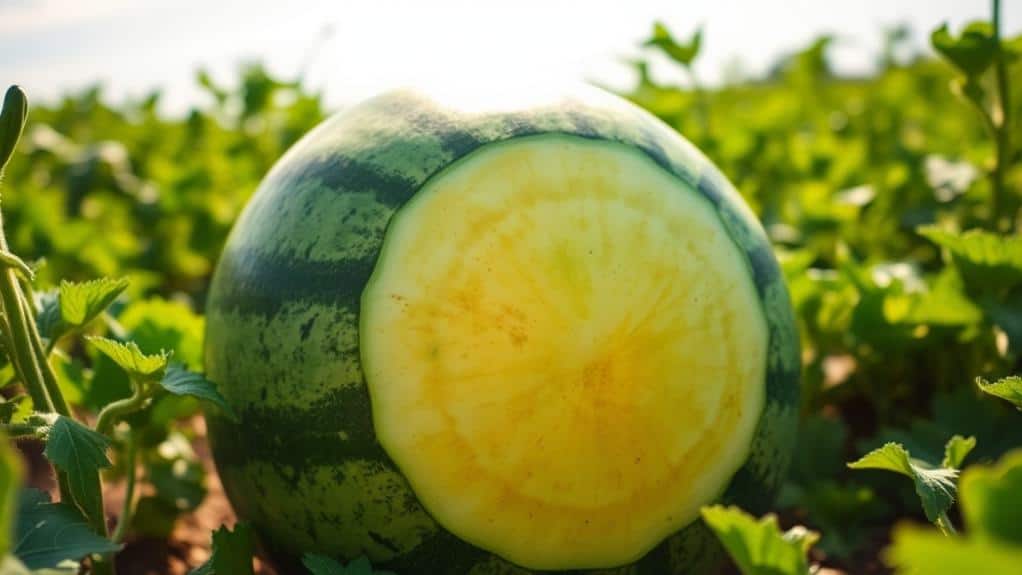
When you're on the hunt for the perfect watermelon, a key indicator of ripeness is the field spot, the creamy yellow patch on the underside where the melon rested on the ground.
This field spot is essential because it tells you a lot about the watermelon's flavor potential. A ripe watermelon will have a deep, buttery yellow field spot, which means it spent enough time on the vine to develop its sweetness.
If the spot is pale green or white, the melon probably isn't ripe and might lack flavor. The field spot results from the loss of chlorophyll during growth, making it a reliable visual cue.
Sugar Spots
When picking a watermelon, look for sugar spots—those brown webbing or black dots on the surface. They show the fruit is full of natural sugars and super sweet.
Just make sure to avoid any that look like they've belly rot, as that can make the melon bitter and spoiled.
Sign of Sweetness
For those of us keenly searching for the perfect watermelon, sugar spots are a telltale sign of ripeness and sweetness. These spots appear as brown webbing or black dots on the surface, indicating high sugar content.
To recognize these signs of sweetness, follow these steps:
- Find brown webbing: Look for brown, net-like patterns on the rind. This webbing shows where the melon has concentrated its sugars.
- Notice black dots: Small black dots also indicate high sugar levels.
- Differentiate from belly rot: Confirm the spots don't resemble rot, which leads to bitterness and potential illness.
A watermelon with pronounced sugar spots is usually sweeter and more desirable.
Keep your eyes peeled for these indicators, and you'll likely find a delicious, ripe watermelon!
Identify Sugar Spots
Identifying sugar spots is essential for selecting the sweetest watermelon. Sugar spots are those brown webbing or black dots you see on the watermelon's skin. These spots form as the fruit matures and sugars concentrate, making the watermelon sweeter and more flavorful.
When you find a watermelon with a significant number of sugar spots, it's a good indication that the fruit is ripe and ready to eat.
However, be cautious and differentiate between sugar spots and signs of belly rot. While sugar spots are a positive sign, belly rot can indicate spoilage and bitterness.
Stick to watermelons with plenty of sugar spots but avoid ones showing extensive belly rot to guarantee you get the best tasting, safest fruit.
Avoid Belly Rot
While sugar spots are a great indicator of sweetness, it's equally important to be cautious about belly rot signs. Sugar spots, those brown webbing or black dots, show that a watermelon is ripe and sweet.
However, belly rot is a different story. It usually appears as dark, soft, and mushy areas.
To avoid belly rot, keep these tips in mind:
- Check for Firmness: A ripe watermelon should be firm all over. Soft spots can signal belly rot.
- Look for Odor: A foul smell indicates spoilage, which means the watermelon is overripe or rotten.
- Examine the Belly: The underside should be creamy yellow, not dark or mushy.
Skin Texture
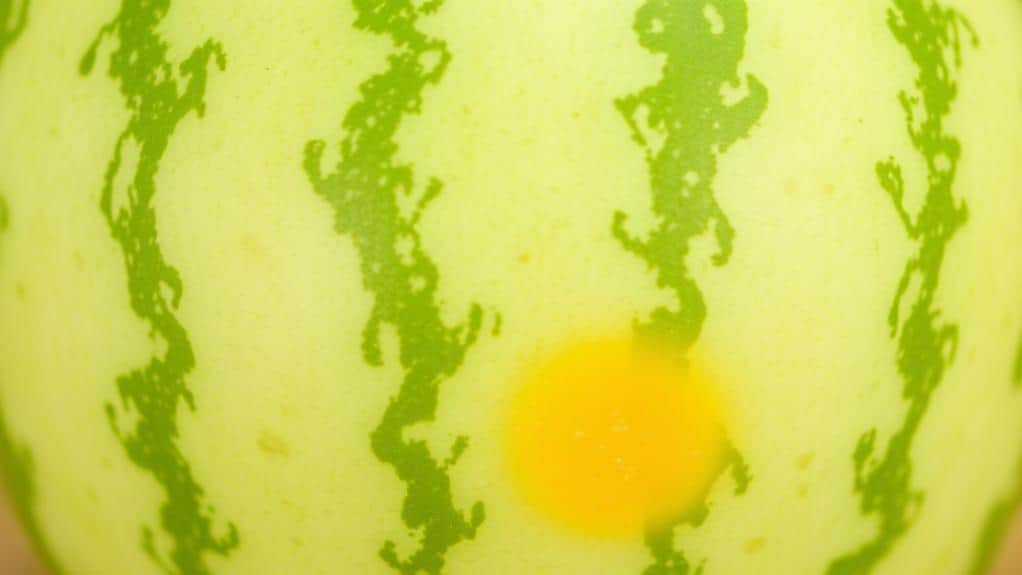
When you're picking out a watermelon, one of the first things to check is the skin texture. Ripe watermelons typically have a dull, matte skin texture, indicating they've matured properly. If the skin is shiny, it's a sign it was picked too early and might lack flavor.
Run your hand over the watermelon; it should feel firm and smooth, with no soft spots or blemishes. A faded top rind from sun exposure is also a good indicator that the watermelon has ripened on the vine.
Shape and Uniformity
When picking a ripe watermelon, I always look for one with a uniform shape.
Odd bumps and curves usually mean it didn't grow evenly, which can lead to inconsistent taste.
A symmetrical melon with a smooth surface tends to be sweeter and juicier, making it a better choice for a tasty treat.
Look for Symmetry
Choosing a watermelon with a symmetrical shape is key to ensuring it has developed properly and will taste great. When I pick a watermelon, I always look for a uniform shape, whether it's round or oval. It's a good sign that the fruit grew evenly on the vine.
Here's what I do:
- Inspect the skin: Make sure it has a dull, matte finish. Shiny skin can mean the watermelon isn't ripe yet.
- Check for uniformity: Avoid melons with bumps, dents, or irregular curves. These can mess with the taste and texture.
- Feel the surface: A smooth, even surface usually means the watermelon is ripe and juicy.
Avoid Odd Bumps
After inspecting the skin and looking for symmetry, I always make certain to avoid watermelons with odd bumps or irregular shapes.
A uniform shape is a key indicator that the watermelon grew consistently, making it more likely to be ripe and delicious. Watermelons with lumps or pronounced curves can mean the fruit experienced stress during growth, which often affects flavor and texture.
A smooth, rounded exterior usually means better quality inside, as irregularities can mess with sugar distribution. Also, look for a dull, matte finish rather than a shiny surface, which often suggests immaturity.
Choosing watermelons with a uniform shape guarantees a sweeter, juicier eating experience.
Happy watermelon hunting!
Frequently Asked Questions
How to Tell When Watermelons Are Ready to Pick?
I always check my watermelons for color changes, look for stem dryness, and do the sound test. A creamy yellow spot, a dry stem, and a hollow sound usually mean they're perfectly ripe and ready to pick.
How Do You Know When a Watermelon Is Ripe in the Store?
Imagine holding a watermelon with a creamy yellow spot, feeling its heft in your hands. The dull skin and a dried, brown stem are perfect indicators. Use the weight test and check the melon color and stem condition.
How Long Should You Leave a Watermelon to Ripen?
I usually leave a watermelon at room temperature for a few days for ideal ripening conditions. Check for signs of overripeness like a too-soft texture. For best harvesting practices, buy during peak season and look for a creamy yellow spot.
Do Watermelons Continue to Ripen on the Counter?
No, watermelons don't continue to ripen on the counter. Look for a creamy yellow spot, a dull skin texture, and a dried stem to guarantee ripeness. The watermelon's internal texture and color won't improve post-purchase.
Conclusion
So, isn't it amazing how many ways you can tell if a watermelon is ripe? Next time you're at the store or in your garden, remember to look for that yellow field spot, lift it to feel the weight, give it a tap for a hollow sound, and check that stem. When you cut it open and see that vibrant red flesh, you'll know you've picked a winner. Happy watermelon hunting, and enjoy the sweet rewards!

